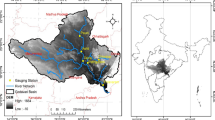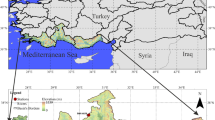Abstract
Information about basin scale climate change is very crucial for utilization, development, and planning of water. The Tapi basin is climatically sensitive. For policymakers, it is important that changes in individual seasons are elucidated. Any earlier study on streamflows of the Tapi basin mentioned in the literature review had not performed trend detection analyses of streamflows of the Tapi basin for four seasons by considering individual month streamflow volume values of given season. Thus, in the present study, trend detection analyses of seasonal streamflow volume time series (1979–2004) of five gauging stations of Tapi basin are carried out for four seasons by considering individual month streamflow volume values of given season. The streamflow data of five gauging stations is selected out of 20 as these are less affected by human activities. Magnitude of trend is assessed by using Sen’s slope (SS) test while statistical significance of trend is assessed by using Mann-Kendall (MK) test and MK with block bootstrapping approach (MKBBS) test for independent and dependent data, respectively. Innovative trend analysis plot and smoothing curve are used for supporting results of trend analysis. The results of the analyses show presence of statistically significant negative trends in winter streamflow volume time series of Burhanpur, Gopalkheda, Lakhpuri, and Yerli gauging stations. Statistically significant negative trends are also detected in pre-monsoon streamflow volume time series of Lakhpuri and Yerli gauging stations. Similarly, statistically significant negative trends are detected in monsoon streamflow volume time series of Gopalkheda and Yerli gauging stations. Statistically significant negative trend is detected in post-monsoon streamflow volume time series of Yerli gauging station as well. The results have shown statistically significant decreasing trends in seasonal streamflows of the gauging station(s) of the Tapi basin.











Similar content being viewed by others
References
Bhamare SM, Agone V (2011) Change detection of surface temperature and its consequence using multi-temporal remote sensing data and GIS application to Tapi basin of India. Proceedings of the global conference on global warming, Lisbon, pp 1–12
Burn DH, Elnur MAH (2002) Detection of hydrologic events and variability. J Hydrol 255:107–122
Deshpande NR, Kothawale DR, Kulkarni A (2016) Changes in climate extremes over major river basins of India. Int J Climatol 36:4548–4559. https://doi.org/10.1002/joc.4651
Hannaford J, Harvey CL (2010) UK seasonal river flow variability in near-natural catchments, regional outflows and long hydrometric records. BHS Third International Symposium Managing Consequences of a Changing Global Environment, Newcastle
IPCC (2007) Summary for policymakers. In: climate change 2007: the physical science basis. Contribution of working group I to the fourth assessment report of the intergovernmental panel on climate change [Solomon S, Qin D, Manning M, Chen Z, Marquis M, Averyt KB, Tignor M, Miller HL (eds.)]. Cambridge University Press, Cambridge, United Kingdom and New York, NY, USA
IPCC (2013) Summary for policymakers. In: climate change 2013: the physical science basis. Contribution of working group I to the fifth assessment report of the intergovernmental panel on climate change [Stocker TF, Qin D, Plattner GK, Tignor, M, Allen SK, Boschung J, Nauels A, Xia Y, Bex V, Midgley PM (eds.)], Cambridge University Press, Cambridge, United Kingdom and New York, NY, USA
Kendall MG (1975) Rank correlation methods. Charless Griffin, London
Khaliq MN, Ouarda TBMJ, Gachon P, Sushama L, St-Hilaire A (2009) Identification of hydrological trends in the presence of serial and cross correlations: a review of selected methods and their application to annual flow regimes of Canadian rivers. J Hydrol 368:117–130
Kundzewicz ZW, Robson A (Eds.) (2000) Detecting trend and other changes in hydrological data. WCDMP-45, WMO/TD –No. 1013, Geneva
Mann HB (1945) Non parametric test against trend. Econometrica 13(3):245–259
Mirajkar AB, Bhuvandas N, Timbadiya PV, Patel PL, Porey PD (2012) Monthly inflow trend analysis of Ukai reservoir using an innovative methodology. National Conference on river hydraulics, Mullana
Singh P, Kumar V, Thomas T, Arora M (2008) Changes in rainfall and relative humidity in river basins in northwest and Central India. Hydrol Process 22:2982–2992
Sen PK (1968) Estimates of regression coefficient based on Kendall’s tau. J Am Stat Assoc 63(324):1379–1389
Sen Z (2012) Innovative trend analysis methodology. J Hydrol Eng ASCE 17(9):1042–1046
Shah HL, Mishra V (2016) Hydrologic changes in Indian subcontinental river basins (1901-2012). J Hydrometeorol 17:2667–2687. https://doi.org/10.1175/JHM-D-15-0231.1
Sonali P, Nagesh Kumar D (2013) Review of trend detection methods and their application to detect temperature changes in India. J Hydrol 476:212–227
Timbadiya PV, Mirajkar AB, Patel PL, Porey PD (2013) Identification of trend and probability distribution for time series of annual peak flow in Tapi basin, India. ISH J Hydraul Eng 19(1):11–20
Zhang X, Harvey D, Hogg WD, Yuzyk TR (2001) Trends in Canadian streamflow. Water Resour Res 37(4):987–998
Author information
Authors and Affiliations
Corresponding author
Rights and permissions
About this article
Cite this article
Kale, G.D., Nagesh Kumar, D. Trend Analyses of Seasonal Streamflows of the Tapi Basin. Water Conserv Sci Eng 4, 1–11 (2019). https://doi.org/10.1007/s41101-018-0062-6
Received:
Revised:
Accepted:
Published:
Issue Date:
DOI: https://doi.org/10.1007/s41101-018-0062-6




